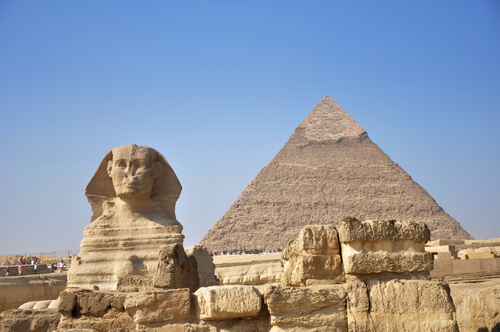Geography’s two main branches are Physical and Human. Cultural geography is part of human geography. A great part of human culture involves religion and ancient rituals. This can be affected by the physical geography of the surrounding environment. Learn geography online by seeing physical geography’s affect on the first two civilizations.
In Egypt the world was seen to be stagnant with never ending cycles(Frankfort: Kingship of the Gods: 1978:4). This first appears to be a paradox but not to the Egyptians. The ruler or pharaoh was seen as the child of the sun god Re, the most powerful of all the Old Kingdom’s gods so what could possibly go wrong? This gave the average Egyptian a sense of security and peace. Egyptian Geography might somehow explain this feeling. Egypt was located around the Nile delta, the Fayum ( City, 81 miles southwest of Cairo, founded 4000 BCE ) and right down the Nile valley to Luxor. The Nile valley had clear cut boundaries and was surrounded by the Sinai and eastern desert on one side and the Sahara on the other. It made invasion difficult. The flooding of the Nile was quite reliable and it’s winters were mild. Life was stable and even death was not considered an end. Hence the Egyptian belief in reincarnation. A food surplus created specialists and a distinct class base.
In Mesopotamia the environment affected the way in which religious celebrations where carried out. The country depended upon the uncertain rainfall of the spring. Human frailty was very much viewed in religion and the uncertainty of life was apparent. The Mesopotamian winters were harsh but the spring brought a pleasant balmy climate ideal for growing crops. The summers were hot and dry and the autumn brought the much needed rainfall. The people had to believe in a god who could triumph over the uncertainty of nature, and at the heart of these ritualistic festivals was the God Tamuz(Frankfort: 1978:3). All the people of the villages participated in these ritualistic festivals which were seen as Tamuz’s triumph over the harshness of winter and the hot dry spells of summer(Frankfort: 1978:3). Religion in a sense tried to harmonize the village community with the unpredictable forces of nature through ritualistic festivals.
The Ubaid period (5300-3600 BCE) the Mesopotamian religion did have it’s own Baru priests. (divinatory or astrological) These were experts in omen prediction. For example , they might make a prediction of next week’s weather by how the smoke curled from the burning of aromatic wood from inside the temple. They were not considered prophets in the Biblical sense because they only made predictions and did not actually know the reasons for the particular outcome.
The first real religious centre fo Sumer was Eridu and it had a small temple. In the late Ubaid period the temple grew in scale . Later Enech (as it is called in the Bible) or Uruk overtook Eridu as the main religious center. The people came to these temples to offer their reverence with sacrifices performed by the priest. The animals throat was cut while citing an incantation. This is very similar to the Hebrew practice of sacrifice as it was first procured by Abraham. He sacrificed a lamb instead of his son Issac before God. Later animal sacrifice was a common practice in Judaism. It was carried out by the high priest in Temple just as it had been in Sumer centuries earlier.
Regarding hymns and prayers we can draw parallels between modern worship of God and the local Sumerian deities. For example, the steadfast loyalty of Gudea of Lagash in expressing piety to the Goddess Gatumgug states: ” My Queen, daughter of the clear sky who gives good advise who occupies the first place in heaven you are the Queen of the mother who founded Lagash…I have no mother you are my mother, I have no father you are my father. In the shrine you have caused me to be born. My Goddess Gatumdug you know all that is good, you have admitted the breath of life unto me.”(Beek: Atlas of Mesopotamia: 1962: 65) The worship of this Goddess is similar to Judeo-Christian concepts of God because they are both considered first in heaven. This Goddess was seen as both mother and father like the Hebrew God Yahweh, (meaning “I am”) was originally considered. This Goddess was believed to have breathed life into man just as God in Genesis is said to have breathed life into Adam.
